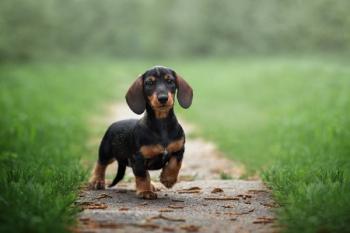
Surgery STAT: Prevent gastric dilatation volvulus with laparoscopic assisted gastropexy
Gastric dilatation-volvulus, or bloat, is a common occurrence in large- and giant-breed dogs.
EDITOR'S NOTE: SurgerySTAT is a collaborative column between the American College of Veterinary Surgeons (ACVS) and DVM Newsmagazine. Next month begins a two-part column by Jeff D. Brourman, DVM, MS, Dipl. ACVS. Dr. Brourman, who is with WestVet Animal Emergency and Specialty Center in Garden City, Idaho, will discuss diagnosing and managing intervertebral disk disease (IVDD), one of the most common conditions affecting chondrodystrophic dogs.
Gastric dilatation-volvulus (GDV) is a common occurrence in large and giant-breed dogs. It occurs when the stomach fills with air and then twists on its own axis (Photo 1). The bloating and twisting cause a cascade of systemic problems that often is fatal if not recognized and treated quickly.
Photo 1: Radiograph of a dog with GDV
Causes that have been proposed include breed, conformation, temperament, diet, exercise associated with eating and underlying stomach disorders. Common recommendations for prevention include feeding large pieces of dog food several times per day, avoiding exercise before or after meals and not feeding from an elevated food bowl.
The only universally accepted method of prevention of GDV is prophylactic gastropexy.
Photo 2: Laparoscopic view of graspers holding stomach
Laparoscopic assisted gastropexy is an elective procedure performed to fix the stomach to the body wall permanently in an effort to prevent twisting of the stomach. General anes-
thesia is necessary.
Use of laparoscope allows gastropexy with two small incisions. The laparoscope is first introduced into the abdomen with a small incision near the umbilicus. The instruments are then introduced through a slightly larger incision behind the last rib on the right. The scope and the instruments are used to grasp a small portion of the stomach (Photo 2) and permanently suture it to the inside of the abdominal wall (Photo 3). Then the instruments and laparoscope are removed and the two incisions are closed.
Postoperative care for patients that have had laparoscopic gastropexy is relatively straightforward. Sutures should be removed in seven to 10 days. The incisions should be inspected daily for excessive redness, swelling or discharge.
Placing an ice compress over the larger incision helps minimize swelling and discomfort. This cold pack should be applied for five minutes two to three times per day for the first three days.
Photo 3: Laparoscopic view of completed gastropexy
If licking at the incision occurs, contact the surgeon or regular veterinarian for advice. The patient's activity level should be restricted during the first two postoperative weeks. We recommend continuing to feed several smaller meals per day of large-sized kibble food and avoiding exercise before and after activity.
Postoperative complications are rare and often involve self-trauma to the incisions. The laparoscopic gastropexy will not prevent bloating but should prevent further stomach twisting. In most cases, recurrence of bloating can be treated with an orogastric tube and medical management.
The prognosis for dogs that have had a prophylactic gastropexy is excellent. There has never been a report of GDV in a dog that has received a prophylactic gastropexy. The laparoscope improves the technique by shortening the time under anesthesia and providing less discomfort than the conventional surgical gastropexy.
It is extremely important that the owners of large and giant-breed dogs be aware of gastric dilatation-volvulus and prepare for it. Owners should educate family and pet caregivers about the warning signs and the noted preventive measures.
Dr. Robbins is an ACVS board-certified surgeon, currently in private practice at Veterinary Specialty Center in Buffalo Grove, Ill. As a member of the ACVS Public Relations Committee, he is actively involved with the Animal Health Condition articles on the ACVS Web site (
Newsletter
From exam room tips to practice management insights, get trusted veterinary news delivered straight to your inbox—subscribe to dvm360.





